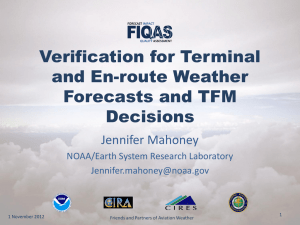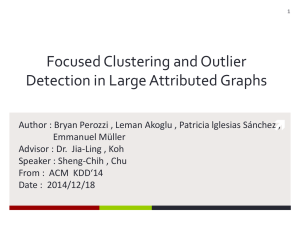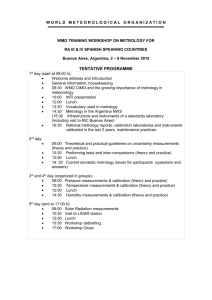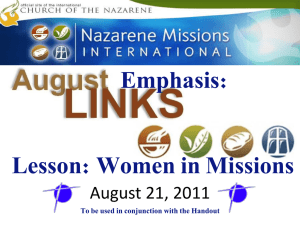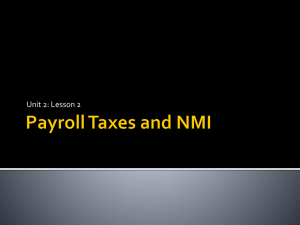Cost Recovery Impact Statement - National Measurement Institute
advertisement
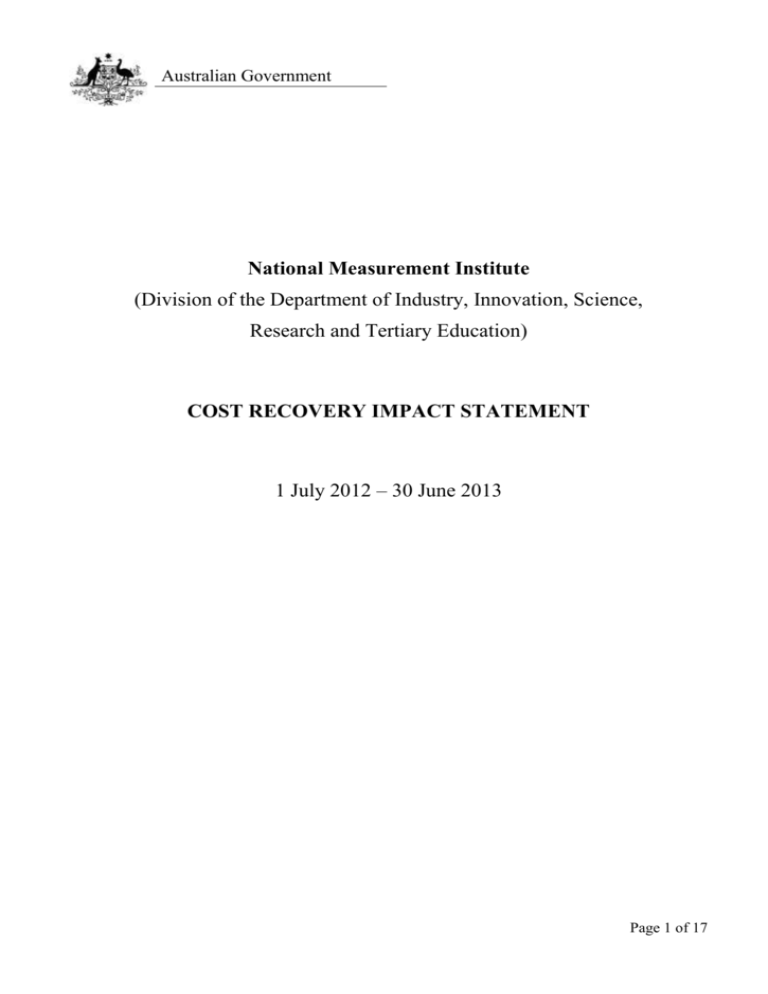
Australian Government National Measurement Institute (Division of the Department of Industry, Innovation, Science, Research and Tertiary Education) COST RECOVERY IMPACT STATEMENT 1 July 2012 – 30 June 2013 Page 1 of 17 National Measurement Institute 2012-13 CRIS Table of Contents 1. OVERVIEW 1.1 Purpose 1.2 Background 1.3 Australian Government Cost Recovery policy 2. POLICY REVIEW – Analysis of Activities 3. DESIGN AND IMPLEMENTATION 4. 3.1 Basis of charging – fee or levy 3.2 Legal requirements for the imposition of charges 3.3 Costs to be included in charges 3.4 Outline of charging structure 3.5 Summary of charging arrangements ONGOING MONITORING 4.1 Monitoring mechanisms 4.2 Stakeholder consultation 4.3 Periodic review 5. CERTIFICATION 6. COST RECOVERY LINKS Page 2 of 17 National Measurement Institute 2012-13 CRIS 1. OVERVIEW 1.1 Purpose The National Measurement Institute (NMI), a division within the Department of Industry, Innovation, Science, Research and Tertiary Education (DIISRTE), has been undertaking activities on a cost recovery basis since its establishment in 2004. Since NMI’s total cost recovery revenue exceeds $5 million a year, NMI’s cost recovery arrangements are considered significant, which triggers a policy requirement to prepare a Cost Recovery Impact Statement (CRIS). The purpose of NMI’s CRIS is to transparently demonstrate compliance of its cost recovery activities with the Australian Government Cost Recovery policy as documented in the Australian Government Cost Recovery Guidelines. This CRIS also replaces NMI’s previous CRIS prepared in 2007 to comply with the policy requirement that cost recovery arrangements should be subject to periodic review no less frequently than every five years. Given a number of significant developments in NMI’s activities over recent years, the allocation of costs between appropriation and cost recovery funded activities, and the underpinning costing methodology, will be reviewed during 2012-13. NMI expects to present recommendations of the review to the Government for consideration during 2012-13 and to develop the next CRIS based on the outcomes of the review process, subject to the Government’s agreement. 1.2 Background The Australian Government announced on 13 May 2003 that it would establish NMI. The announcement was part of the Government’s 2003-04 Budget initiatives. On 25 March 2004, the legislation establishing NMI, the National Measurement Amendment Act 2004, received Royal Assent. Establishment of NMI merged the National Standards Commission, the National Measurement Laboratory (a national facility within CSIRO) and the Australian Government Analytical Laboratories into a single organisation. The Government provided $3 million from the resourcing of the then Department of Industry, Tourism and Resources for the establishment of NMI. No new funding was provided for NMI at the establishment, with existing funding for the three amalgamating organisations constituting the funding of NMI. The National Measurement Amendment Act 2004 amended the National Measurement Act 1960 to establish NMI and to introduce governance and operational arrangements for it. The NMI was established within the then Department of Industry, Tourism and Resources as a clearly identified unit of a specialist nature with specified functions set out in the National Measurement Act 1960, with metrological functions of the Commonwealth given to the Secretary. The Explanatory Memorandum to the National Measurement Amendment Bill 2003 clarified that the Commonwealth may make charges for services in connection with the functions given to the Secretary; and that this is a normal part of the operation of the constituent agencies, which provide services on a cost recovery basis or in line with market rates. Page 3 of 17 National Measurement Institute 2012-13 CRIS NMI began operating within the then Department of Industry, Tourism and Resources from 1 July 2004. After a number of machinery-of-government changes, NMI is currently a division within DIISRTE. NMI carries out statutory functions under the National Measurement Act 1960 and its subordinate regulations that: o prescribe Australia’s units of measurement; o assign responsibility for maintaining the national standards that realise these units of measurement; o define the metrological control infrastructure that is required to assure the accuracy and reliability of measuring instruments used for trade and regulation; and o prescribe the operations of the National Trade Measurement system, which commenced on 1 July 2010. NMI’s budget comprises a combination of appropriation (taxpayer) funding and fees for services provided. Appropriation funding supports NMI’s work as the peak body in Australia’s measurement system, that is, in developing and maintaining the legislative framework and the national measurement standards, and in ensuring the international acceptance of Australia’s measurement system and standards. Where work is carried out specifically for the benefit of a particular organisation or business, NMI charges for its services and seeks to recover relevant costs, in accordance with the Government’s Cost Recovery Guidelines. A more detailed description of NMI’s measurement services on a fee-for-service basis is provided in Section 2 of this CRIS. The 2011-12 NMI budget included approximately $48 million in appropriation funding and $34 million in fee revenue from both government and industry clients. On 13 April 2007, the Council of Australian Governments (COAG) decided to establish a national system of trade measurement funded and administered by the Commonwealth. In line with the above decision, the Government, in the 2007-08 Budget, provided $30.1 million over four years (until 201011) to establish a national trade measurement system assuming the role undertaken by state and territory governments. The funding supported the establishment of a national licensing system for private sector certifiers of trade measuring instruments and a national trade measurement inspectorate within NMI. The measure also included $3 million in capital funding from 2009-10 to 2010-11 for leasehold improvements at Australian Government offices. The allocated funding included an amount of $0.8 million for the Office of the Commonwealth Director of Public Prosecutions. Amendments to the National Measurement Act 1960 were made in December 2008 to give effect to the COAG’s decision. The corresponding National Trade Measurement Regulations 2009 were made in September 2009. NMI began administration of the national measurement system on 1 July 2010. In the 2009-10 Budget, the Government announced the National Enabling Technologies Strategy with funding of $38 million over four years (2009-10 to 2012-13). This measure included funding of $18 million for NMI to deliver measurement capability for biotechnology and nanotechnology that supports effective regulation and improved industry uptake. Page 4 of 17 National Measurement Institute 2012-13 CRIS 1.3 Australian Government Cost Recovery Policy In December 2002 the Australian Government adopted a formal cost recovery policy to improve the consistency, transparency and accountability of its cost recovery arrangements and promote the efficient allocation of resources. The underlying principle of the policy is that entities should set charges to recover all the costs of products or services where it is efficient and effective to do so, where the beneficiaries are a narrow and identifiable group and where charging is consistent with Australian Government policy objectives. Cost recovery policy is administered by the Department of Finance and Deregulation and outlined in the Australian Government Cost Recovery Guidelines (Cost Recovery Guidelines). The policy applies to all Financial Management and Accountability Act 1997 (FMA Act) agencies and to relevant Commonwealth Authorities and Companies Act 1997 (CAC Act) bodies that have been notified. In line with the policy, individual portfolio ministers are ultimately responsible for ensuring entities’ implementation and compliance with the Cost Recovery Guidelines. 2. POLICY REVIEW – ANALYSIS OF ACTIVITIES NMI undertakes a diverse range of activities related to measurement. The diversity of NMI’s activities means that a variety of user charging arrangements apply. For example, competitive neutrality considerations are taken into account in user charging for Analytical Testing Services and Dioxin Analysis, or when bidding on on Commonwealth Government tenders. Where NMI receives grant revenue it observes the terms of the grant in using the grant funds. For cost recovered activities covered by this CRIS, NMI charges government and non-government clients on the same basis for identical activities. These cost recovery activities can be grouped as follows: o Chemical and Biological Metrology Services o Legal Metrology Services o Metrology Training Services o Physical Metrology Services In the tables that follow, historical trends have been used to estimate forward external revenues and the same basis has been used to estimate costs for information activities. The exceptions are metrology training services which are subsidised from appropriation (taxpayer) funding and the high voltage laboratory, flow facility, trade measurement laboratories related activities where cost recovery is being phased in. Chemical and Biological Metrology Services Certified Reference Materials NMI conducts ongoing research to produce an up-to-date range of certified chemical reference materials (CRMs) relevant to NMI’s and Australian strategic requirements. This work is done as part of appropriation funded activities to fulfill NMI’s responsibilities under the National Measurement Act 1960 Section 18 (2)(b) “ realising units of measurement through the development and maintenance of standards of measurement, reference materials and reference techniques”. The development of CRMs of reliability appropriate to NMI requires specialised scientific capabilities of the highest order that are not generally available commercially in Australia. Page 5 of 17 National Measurement Institute 2012-13 CRIS NMI uses CRMs to support the development and delivery of new services and to underpin the accuracy of its internal analysis services. NMI sells CRMs to Australian laboratories where they are used (as consumables) for the same purpose. A technically practical production volume of CRMs generates a significant surplus that is inventoried and carefully stored. There is ongoing Australian and international demand for this inventory. NMI participates in international co-ordination efforts to optimise the range of CRMs available across the globe. Proficiency Testing NMI provides proficiency testing (PT) services to chemical laboratories in Australia in areas such as food, forensic and environmental testing. This is done to fulfill NMI’s responsibilities under the National Measurement Act 1960 Section 18 (2)(d) “promoting best practice in measurement in industry and the scientific and wider community, including by training;” Proficiency testing is a means of assessing the ability of laboratories to competently perform specific tests and measurements. In order to gain and maintain National Association of Testing Authorities (NATA) accreditation, laboratories are required to participate in proficiency testing schemes such as that administered by NMI. PT provides assurance on the quality of testing laboratories around Australia thereby supporting activities including safe food production, environmental protection and law enforcement. NMI’s PT services are currently not fully cost recovered so as to encourage their uptake, consistent with National Measurement Act 1960 Section 18 (2)(d) above. Charges for proficiency testing will be re-evaluated as part of the NMI’s cost recovery review in 2012-13. Gas PT and standards NMI also develops and maintains standards for gas composition measurement, referred to as reference gas mixtures. NMI is a sole provider of proficiency testing in gas for Asia Pacific region. The rationale for this work is the same as set out above for CRMs and PT. Chemical and Biological Metrology Services Cost Recovery Revenue and Expenditure for 2011-12 $000 Sale of CRMs Proficiency Sale of gas testing of 3rd proficiency testing party laboratories schemes and standards Costs 1002 664 100 Cost recovery revenue 1002 245 100 - from public sector 111 0 0 - from private sector 891 245 100 Appropriation funding 0 419 0 Page 6 of 17 National Measurement Institute 2012-13 CRIS Legal Metrology Services The Legal Metrology branch is responsible for measurements used for trade and other legal purposes under the National Measurement Act 1960 and subordinate legislation. It is responsible for trade measurement, including pattern approval of instruments and issuing of licences for verification of instruments. Since federation, trade measurement regulation has been administered by each Australian State and Territory. As of 1 July 2010, NMI has assumed responsibility for regulation and administration of a national system of trade measurement as per the COAG decision made in 2007 (further information on the national trade measurement system is provided in Chapter 1 of this CRIS). It should be noted that currently NMI does not recover costs of trade measurement compliance and enforcement activities as direct charging for these activities is considered counter-productive. While NMI is currently appropriation funded for these activities, the policy rationale for appropriation funding and possibility of cost recovering some of these activities will be investigated as part of the cost recovery review in 2012-13. Trade Measurement Laboratory Services NMI's Trade Measurement Laboratories provide industrial-level calibration and certification testing services to both public and private sector clients, which include government departments, traders, industry, servicing licensees and other organisations such as sporting bodies. As part of transition to the national system of trade measurement, NMI inherited State and Territory fee schedules for Trade Measurement Laboratory services some of which were set well below full cost recovery levels. To ensure a smooth transition to a single national fee structure NMI has embarked on a gradual phase-in of full cost recovery over a longer term, involving fee increases of up to 10 per cent per year. For the above reasons Trade Measurement Laboratory services are currently partially cost recovered while the cost recovery is being phased in. NMI will re-evaluate the appropriateness of the above rate of phasing in full cost recovery fees as part of the cost recovery review in 2012-13 present any relevant recommendations for Government’s agreement prior to implementing any changes to this approach. Trade Measurement Licensing Individuals and organisations involved in verifying measuring instruments used for trade are required to hold a servicing licence. In addition, owners of public weighbridges are required to hold a public weighbridge licence. A licence is granted once NMI is satisfied that an applicant meets the licence criteria under the National Measurement Act 1960 and the licence conditions under the National Trade Measurement Regulations 2009. NMI has assumed responsibility for issuing licences as the regulator and administrator of a national system of trade measurement which commenced on 1 July 2010. The cost of issuing a licence is recovered via an application fee, with a licence valid for three years, however this fee does not include the costs of licensee monitoring and compliance activities. As part of the cost recovery review in 2012-13, NMI will consider appropriate charging options for licensee monitoring and compliance activities. Servicing licensee fees are prescribed under Division 2.4 and Public Weighbridge licence fees are prescribed under Division 3.2 of the National Trade Measurement Regulations 2009. Page 7 of 17 National Measurement Institute 2012-13 CRIS Pattern Approval Manufacturers and importers of measuring instruments (e.g. retail scales, weighbridges, petrol dispensers, breath-alcohol analysers etc) are generally required to have a Pattern Approval certificate from NMI before instruments can be used for trade or regulatory purposes in Australia. The process of issuing a Pattern Approval certificate involves NMI testing the equipment under a range of conditions to ensure that the measurements provided by the equipment are accurate under the conditions in which they are likely to be used. NMI does not have any competitors for its statutory pattern approval activities. Pattern approval fees currently do not recover the full cost of pattern approval activities, Pattern approval through an Australian authority underpins confidence in the accuracy of measuring instruments used for international and local trade without undue reliance on overseas authorities, whose focus may not be on protecting Australian trading interests. Most international jurisdictions retain national responsibility for regulatory decision-making of this kind. The measuring instrument manufacturing industry is an international industry with Australian and overseas participants. Due to population, geography and politico-economic factors including regional trading arrangements, the effective market size for instruments assessed by many overseas pattern approval authorities is much greater than for Australia, so instrument manufacturers may spread the costs of pattern approval in those jurisdictions over a greater number of instruments. By comparison Australian pattern approval costs may seem disproportionately high in the context of the international industry. Since pattern approval acts as part of the fundamental infrastructure for supporting reliable and accurate trade measurement, it is important that Australia is able to benefit from innovations in this field. High pattern approval fees may act as barrier to uptake of innovation in Australia in this field. Partial cost recovery reduces this barrier and, when combined with mutual acceptance arrangements, also promotes Australian industry participation in the production of measuring instruments used for trade. Pattern Approval fees are set by regulation with the fee structure detailed in Schedule 13 of the National Measurement Regulations which can be accessed at http://www.comlaw.gov.au/Details/F2011C00445 Appointment of Legal Metrology Authorities NMI has the power to appoint authorities that can offer services to support the needs of the national measurement system. The names and contact details of the legal metrology authorities appointed by NMI are listed on NMI’s website. Legal Metrology Services Cost Recovery Revenue and Expenditure for 2011-12 $000 Laboratory Trade Pattern Appointment of Services Measurement Approval Legal Metrology Licensing Authorities Costs 1242 456 1438 25 Cost recovery revenue 562 500 513 25 - from public sector 80 0 15 0 - from private sector 482 500 498 25 Appropriation funding 680 (44) 925 0 Page 8 of 17 National Measurement Institute 2012-13 CRIS Metrology Training Services NMI provides metrology training services to improve measurement skills in the Australian economy. This is done to fulfil NMI’s responsibilities under the National Measurement Act 1960 Section 18 (2)(d) “promoting best practice in measurement in industry and the scientific and wider community, including by training;” Metrology training is highly specialised, and there is limited competition between Australian training providers in this field. NMI conducts training courses only where there is no other suitable Australian provider and where there is a demonstrated need to support the national measurement system. The full cost of providing metrology training services is high and may be viewed as prohibitive for potential participants. NMI presently recovers approximately 50 per cent of the direct cost of providing training services, with the remainder of costs met from appropriation funding. NMI has set the share of costs recovered so as to encourage uptake of training by industry, government and wider community while recovering some of NMI’s costs in training delivery. In setting the charges, NMI also has regard to prices charged by other training providers for training courses of a similar specialist nature. Charges for training will be re-evaluated as part of the NMI’s cost recovery review in 2012-13. Metrology Training Services Cost Recovery Revenue and Expenditure for 2011-12 $000 Costs 1005 Cost recovery revenue 450 - from public sector 93 - from private sector 357 Appropriation funding 555 Physical Metrology Services Calibration and Consulting Services NMI provides calibration of equipment to the highest levels of accuracy, directly traced to primary Australian measurement standards. NMI uses its high-level expertise to develop calibration methodologies for new and complex devices which cannot be calibrated by commercial laboratories. NMI also provides contracted and consulting services to develop and manufacture highly specialised scientific equipment for particular applications. In most cases, NMI is able to provide services with a level of technical integrity, an extent of international recognition, or a formal standing in Australia’s legal system which is not matched by the private sector. Calibration services are provided to both public and private sector clients. To avoid significant impact on actual or potential competitors, NMI discusses requirements for major calibration projects with a potential client, and if the level of accuracy is such that other laboratories could undertake the work, the client is referred to those laboratories. In general, NMI provides calibration services only when other competitors are unable to provide such services or to provide them with the level of accuracy required. Page 9 of 17 National Measurement Institute 2012-13 CRIS High Voltage Laboratory and Flow Facility NMI maintains custom calibration facilities in the area of high voltage measurements and liquid hydrocarbon flow. These facilities do not maintain realisations of primary physical units for Australia, and are consequently dependent on other physical metrology standards, but are nevertheless important for Australian industry and infrastructure. The High Voltage Laboratory provides calibration and testing services for high voltage instruments and systems such as voltage and current transformers or insulator assemblies used in supply grids. No other laboratory is able to match the high accuracy services provided by NMI, nor provide the very wide range of parameters (for example, impulse voltages to 2.5 MV and above) used for testing services. Although some of these services could in principle be provided by overseas national institutes, this is not viable for Australian clients in practice owing to prohibitive shipping costs, extended downtime of production systems, and limited ability to interact with the service provider. The Flow Facility provides calibration and measurement services for LPG and other liquid hydrocarbon flow meters, previously provided by the National Standards Commission (NSC) prior to its incorporation into the NMI in 2004. A new facility was commissioned at Londonderry in Western Sydney in October 2009. This allows these important services to be delivered safely. Fees for services provided by the High Voltage Laboratory and Flow Facility do not currently recover the full cost of operating these facilities, with the remainder met from appropriation funding. Ability to recover these costs is limited by industry demand. The policy arguments for ongoing partial cost recovery and any potential impact on the fees for these services will be re-evaluated as part of the NMI’s cost recovery review in 2012-13. Physical Metrology Services Cost Recovery Revenue and Expenditure for 2011-12 $000 Calibrations1 Consulting1 High Voltage Flow Facility Costs 1,489 1,160 1,583 468 Cost recovery revenue 1,489 1,160 385 55 - from public sector 285 0 74 11 - from private sector 1,204 1,160 311 44 Appropriation funding 0 0 1,198 413 1 Calibration and consulting services exclude those provided by the High Voltage Laboratory and Flow Facility. 3. DESIGN AND IMPLEMENTATION This section explains how NMI establishes charges for cost recovery activities. 3.1 Basis of Charging – Fee or Levy NMI charges are invoiced to each client on a fee for service basis. NMI does not recover any costs through levies. 3.2 Legal Requirements for the Imposition of Charges The metrological functions of the Commonwealth are set out in section 18 of the National Measurement Act 1960 (the Act). Page 10 of 17 National Measurement Institute 2012-13 CRIS Under subsection 18(1), the Secretary has metrological functions of the Commonwealth which are outlined as a non-exhaustive list under subsection 18(2). Subsection 18(3) of the Act states that: “The fact that the Secretary has the functions mentioned in this section does not limit the power of the Commonwealth to charge fees for things done in performing those functions.” This allows the Commonwealth to charge fees for the metrological functions of the Commonwealth. Subsection 18C of the National Measurement Act 1960 states that: “The Secretary may delegate all or any of his or her functions or powers under this Act or the regulations to: (a) an SES employee or acting SES employee in the Department; or (b) the Chief Metrologist; or (c) an APS employee within the National Measurement Institute who has the expertise appropriate to the function or power delegated. (s18(2) in writing) Subsection 18A(2) states that the Chief Metrologist has the functions conferred on him or her under the Act and regulations. Subsection 18A(3) states that “The fact that the Chief Metrologist has the functions conferred on him or her under this Act and the regulations does not limit the power of the Commonwealth to charge fees for things done in performing those functions.” This allows the Commonwealth to charge fees for the functions of the Chief Metrologist conferred on him under the Act and regulations. Additionally the Commonwealth has the power to charge fees as outlined in the National Measurement Regulations 1999 (Cth) (the Regulations). Subsection 20(1) of the Act allows the Governor –General to make regulations which are necessary and convenient to be prescribed for carrying out or giving effect to the Act. In particular, paragraph 20(1)(k) allows for the regulations to include the prescribing of fees for applications. Paragraph 20(1)(l) allows for the regulations to prescribe fees for activities undertaken in respect of: the examination and certification of patterns of measuring instruments; the verification of measuring instruments used for trade; the issue of a certificate in relation to the verification of a measuring instrument used for trade; and the issue of a permit for a packed article under Division 5 of Part VI of the Act. In relation to the National Measurement Institute’s regulatory services, subsection 20(2) of the Act states that: “The regulations may set a fee mentioned in subsection (1) by setting the amount of the fee or a way of working out the fee.” Subsection 20(3) of the Act states that: “A fee mentioned in subsection 20(1) must be reasonably related to the expenses incurred or to be incurred for the activities undertaken and must not be such as to amount to taxation.” The Regulations contain a fee structure in Schedule 13 for the National Measurement Institute’s regulatory services. This was initially made on 1 July 2004 and has been amended each year from 2007 to 2012, normally with effect from 1 July. 3.3 Costs to be Included in Charges NMI’s cost recovery charges include direct and indirect costs which can be identified specifically with or traced to an activity in an economically feasible way. It is important to note that both cost recovered and appropriation funded activities are often performed by the same organisational unit, using the same staff, equipment and laboratory space. Staff time is used as the proxy for allocating costs as described in detail in the example below. Page 11 of 17 National Measurement Institute 2012-13 CRIS A significant component of NMI’s cost recovery revenue arises from one off or specialised jobs. Generally NMI uses staff time as the main proxy for estimating costs and charges for jobs for its clients. The hourly rate is established for each activity as described below and includes indirect or overhead costs attributable to the activity (detailed below). Time spent on the activity comprises time spent directly on the client’s job plus where applicable time spent in support of the activity. If specific goods or services need to be procured by NMI for a particular job those direct costs are passed on to the client in full. In the interests of efficiency and where it is reasonable to do so a particular salary classification rate may be selected for pricing particular activities. In cases where a particular activity should take a consistent amount of time and resource, a fixed fee is established as the basis for charging clients. As previously mentioned fees for some Legal Metrology services are set by regulation - in those cases the prescribed fee is charged. A more detailed description of the current charging methodology follows together with a worked example. Exceptions to the method described here are detailed in section 3.4. Generally expenses are allocated to activities based on staff time spent on the job and their expertise approximated by their salary level. In most cases, an hourly rate has been calculated as the basis for charging. The hourly rate is calculated on the following principle: Hourly Salary Rate per Classification Level X Expense Allocation Factor = Hourly Rate The annual salary rate for each classification level is set by the Enterprise Agreement, the conversion from an annual salary to an hourly salary rate is based on the working hours per annum. The result is then discounted to allow for time spent on internal activities that don’t relate directly to the services being provided. The Expense Allocation Factor is calculated by dividing all the expenses directly traceable to an organisational unit by the salary only expense allocated to that unit. This method assumes the driver of expenses is staff time and expertise, that is the amount of operational expenses consumed, laboratory space occupied and equipment operating hours is driven by the staff member involved directly in the cost recovery activity. For information products that are subject to the cost recovery guidelines, only those cost components that would not have been incurred if the product was not provided are included in the expense allocation factor. Specifically, cost components included in cost recovery through the expense allocation factor are: o Employee expenses – salary and on-costs for staff directly involved in an activity, such as workers compensation insurance; o Operational expenses – include laboratory consumables, contractors, repairs and maintenance for laboratory equipment and administrative expenses to coordinate an activity; o Property expenses – lease costs for laboratory and administrative offices; o Depreciation – depreciation on assets used in activity; and o IT maintenance expenses – corporate information technology charges. Page 12 of 17 National Measurement Institute 2012-13 CRIS Costs which have been excluded from cost recovery charges by excluding them from the expense allocation factor are: o Executive, specifically NMI CEO/Chief Metrologist and Senior Executive Officers; o NMI corporate and finance management; o Quality assurance and occupational health and safety services; o Information management, including records management system and library; o Compliance with international metrology treaty obligations; o Insurance; and o Corporate services attributable to the main Department (DIISRTE). As part of the review of NMI costing methodology in 2012-13, NMI will re-assess which overhead costs may be appropriate for recovery. A worked example: 1. Calculation of Expense Allocation Factor: Costs for Organisational Unit: Employee Expense + On costs Operational Expense Property Depreciation IT Maintenance Total “Directly Attributable” Expenses for Organisational Unit Divided by Employee Expense Expense Allocation Factor $’000s 3,390 500 1,000 1,200 140 6,230 2,800 2.23 2. Calculation of Hourly Rate: Salary Rate per Classification Level NMI APS 6 $63 per hour X Expense Allocation Factor = Chargeable Hourly Rate X 2.23 = $140 per hour 3. Calculation of Cost Recovery Charge: Chargeable Hourly Rate X Time Spent on Activity = Charge $140 per hour X 4 hours = $560 No specific indexation rate is applied to charges from year to year, however the calculation method incorporates increases in cost components. Page 13 of 17 National Measurement Institute 2012-13 CRIS 3.4 Outline of Charging Structure The following outline the charging structure and identify deviations from the methodology described in Section 3.3 “Costs to be Included in the Charges”. Links to published prices lists have been included. Chemical and Biological Metrology Services Sale of CRMs Proficiency testing of 3rd party laboratories Charging Structure As outlined in Section 3.3 Cost, market and historical considerations Sale of gas proficiency testing schemes and standards Cost, market and historical considerations Published Price List NMI Website at: http://www.measureme nt.gov.au/Services/Page s/ChemicalReferenceM aterials.aspx NMI Website at: http://www.measureme nt.gov.au/Services/Page s/ChemicalProficiencyT esting.aspx NMI Website at: http://www.measureme nt.gov.au/Services/Page s/ReferenceGasMixture s.aspx Legal Metrology Services Laboratory Services Charging Structure Published Price List Trade Measurement Licensing Pattern Approval As outlined in Section 3.3 moderated by market and historical considerations Regulation: Regulation: National Trade Measurement Regulations 2009 Schedule 13 of the National Measurement Regulations 1999 NMI Website at: http://www.meas urement.gov.au/T radeMeasuremen t/Pages/TradeMe asurementService s.aspx http://www.comla w.gov.au/Details/ F2011C00446/Ht ml/Text#_Toc298 151305 http://www.comla w.gov.au/Details/ F2011C00445/Ht ml/Text#_Toc298 146465 Appointment of Legal Metrology Authorities As outlined in Section 3.3 $1,100 per appointment for three year term Metrology Training Services Charging Structure: as outlined in Section 3.3, however in some cases the hourly rate is discounted based on the “National interest” in section 18(d) of the National Measurement Act 1960 Published Price List: NMI Website at http://www.measurement.gov.au/Services/Training/Pages/default.aspx Page 14 of 17 National Measurement Institute 2012-13 CRIS Physical Metrology Services Calibrations Consulting As outlined in Section 3.3 Charging Structure Published Price List 3.5 High Voltage Cost, market and historical considerations Flow Facility Cost, market and historical considerations NMI Website at: http://www.measurement.gov.au/Services/calibrationtesting/Pages /default.aspx Summary of Charging Arrangements Estimated costs and revenue for NMI’s cost recovery activities for 2012-13 Activity ($’000s) Chemical and Biological Metrology Services Sale of certified chemical reference materials Proficiency testing for laboratories Reference gas mixtures Legal Metrology Services Trade measurement laboratory services Trade measurement licensing Pattern approvals Appointment of legal metrology authorities Metrology training services Physical Metrology Services Calibration and Consulting Services High Voltage Laboratory services Flow Facility services Volume (no. of services) Various Total Cost Cost Recovery Revenue From From Public Private Sector Sector Appropriation Funding 1,030 114 916 0 729 0 255 474 105 0 105 0 Various 1,254 61 368 825 200 300 certificates for approval 90 renewed every three years 95 courses 10 consultancy courses 500 1,532 0 16 500 546 0 970 25 0 25 0 1,095 104 395 596 840 2,020 193 1,827 0 Various 1,674 79 333 1,262 Various 506 11 47 448 21 schemes with 8-40 participants 34 PT samples 3 Gas Analysis 12 Gas Cert 9 Gas Std Page 15 of 17 National Measurement Institute 2012-13 CRIS 4. ONGOING MONITORING 4.1 Monitoring Mechanisms NMI monitors both expenditure and revenue for all organisational units and cost centres on a monthly basis so changes in trends or the volume of activity can be identified without unreasonable delay. NMI will also continue to monitor changes in policy requirements and implement changes to its business processes in response to policy changes that may arise in the future. Cost recovery revenue will be reported in DIISRTE’s annual financial statements in accordance with the Finance Minister’s Orders. 4.2 Stakeholder Consultation NMI consults widely with stakeholders at national and international forums. NMI uses a number of consultation methods for the different activities, for example: o Stakeholder surveys including a value for money question. Most recently these were conducted by the Physical Metrology and Legal Metrology branches in 2009 and 2011 and by the Chemical and Biological Metrology branch in 2010. o Any proposed variations to the fees set out in regulations undergo normal legislative change processes which involve consultation with industry and other stakeholders. o Trade Measurement laboratory services: clients are advised by letter of an annual fee increase six months prior to the increase and again a month before it is implemented in July each year. New fees are posted on the NMI’s website in June (a month before the annual increase). o Pattern approval: major industry groups representing instrument manufacturers are consulted prior to any significant change in pattern approval fees. Both major and minor changes in fees are subject to Ministerial approval before being implemented. Prior to implementation, fees are published on the NMI’s website and companies which have had recent contact with NMI in regards to a pattern approval submission are notified by letter. o Feedback from participants is sought after each training course. o NMI is included in the Department’s annual stakeholder satisfaction surveys. 4.3 Periodic Review Given a number of significant developments in NMI’s activities over the recent years, it is timely to review the allocation of costs between appropriation and cost recovery funded activities. NMI will undertake the review during 2012-13, which will include review of NMI’s costing model. The review will also include an appropriate level of consultation with affected stakeholders. NMI expects to present recommendations of the review to the Government for consideration during 2012-13 and to develop the next CRIS based on the outcomes of the review process, subject to the Government’s agreement. Page 16 of 17 National Measurement Institute 2012-13 CRIS Page 17 of 17
